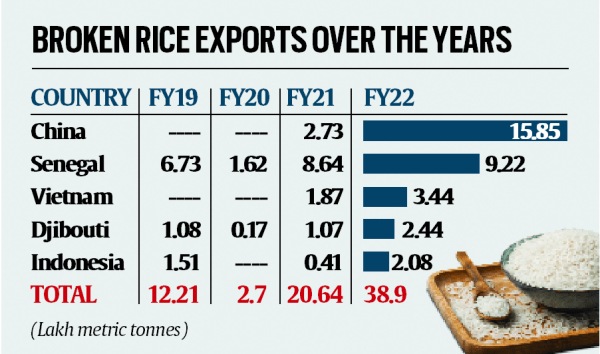The Union government Friday banned the export of broken rice while flagging an increase in its price, a shortage in supply for domestic requirements and, significantly, an “abnormal” increase in exports.
The move came a day after the government imposed a 20 per cent export duty on all non-basmati rice except par-boiled rice.

Observing that broken rice exports have increased 42 times to 21.31 lakh metric tonnes (LMT) during April-August 2022 as compared to 0.51 LMT during the corresponding period of 2019, Food Secretary Sudhanshu Pandey Friday said: “This is not a normal increase of exports. This is absolutely abnormal.”

He also shared country-wise data that shows China was the top buyer (15.85 LMT) of Indian broken rice in 2021-22.
On June 14, The Indian Express had reported that China has emerged as the top buyer of Indian rice during the pandemic, with the neighbouring country importing 16.34 LMT — or 7.7 per cent — of India’s total rice export of 212.10 LMT in 2021-22. out of China’s total rice import from India of 16.34 LMT, nearly 97 per cent, or 15.76 LMT, was broken rice.
Pandey said the price, which was around Rs 15-16 per kg as on January 1 this year, has increased to Rs 22 per kg as on September 8.
ExplainedRise in export share
The share of broken rice in the total rice exports increased to 22.78 per cent during April-August 2022 from 1.34 per cent in the corresponding period of 2019, government data show. This came even as China emerged as a major buyer of broken rice. The Food Secretary said this increase in export share is not normal.
“As a result, broken rice is also not available either for poultry feed or for ethanol for which they were using broken rice or damaged foodgrains,” he said. “Therefore, for the time being, broken rice export has been stopped and a transition period has been given.”
Story continues below this ad
In a notification, the Directorate General of Foreign Trade (DGFT) said: “Export Policy of broken rice… is amended from ‘Free’ to ‘Prohibited’.”
Pandey stated: “If you see the broken rice export figure for the full financial year, it shows an increase of more than 300 per cent from 12.21 lakh metric tonnes in 2018-19 to 38.90 LMT in 2021-22. This is also an exponential increase. This is not a normal increase by any stretch of imagination. If your exports are growing by 4 or 5 or 6 per cent, then this increase is abnormal.”
The ban will come into effect from September 9. However, relaxation has been given to three categories where consignments of broken rice will be allowed between September 9 and 15. First, where loading of broken rice on the ship has commenced before the notification. Second, where the shipping bill is filed and vessels have already berthed or arrived and anchored in Indian ports and their rotation number has been allocated before the notification (the approval of loading in such vessels will be issued only after confirmation by the concerned port authorities regarding anchoring/berthing of the ship for loading of broken rice prior to the notification). Third, where broken rice consignment has been handed over to Customs before the notification and is registered in their system.
Newsletter | Click to get the day’s best explainers in your inbox
Story continues below this ad
Referring to the imposition of 20 per export duty on all non-basmati rice except par-boiled rice, Pandey said that it would lead to lowering of prices of rice in the domestic market.
Pandey also said that the total rice sowing during the current kharif season has been so far about 20 lakh hectare less as compared to the corresponding figure of the last year. The rice production may fall by 10 million tonnes and in the worst case it can be 12 million tonnes [shortfall] this year due to a variety of factors, he said.










